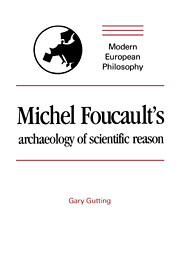Book contents
5 - The order of things: II. The rise and fall of man
Published online by Cambridge University Press: 05 June 2012
Summary
The modern episteme
As is the case with any episteme, that of the modern age involves a fundamental reordering of reality, a new way of regarding things and their interrelations. The basic realities are no longer elements related to one another by identities and differences in their properties. Foucault presents them as rather “organic structures,” connected to one another by analogies between their structures and hence between their functions. As a result, he says, the essential reality of things is not located in the continuous series that they form in an ideal conceptual space. It is found rather in their existence as discrete structures. Further, their similarities of structure are not due to “their adjacency in a classificatory table [but to] the fact that they are close to one another in a temporal succession” (218). A thing is what it is not because of its place in the ideal classification system but because of its place in real history. The order of concretely existing things is from now on determined not by ideal essences outside them but by the historical forces buried within them.
Corresponding to this new conception of order, there is, Foucault maintains, a new conception of the sign, one that displaces the central role the Classical Age gave to representation. He therefore speaks of modernity as closely tied to a “decline” or “failure” of representation. In this regard, however, it is crucial to keep in mind that Foucault does not mean that the modern episteme eliminates representation as a function of thought.
- Type
- Chapter
- Information
- Michel Foucault's Archaeology of Scientific ReasonScience and the History of Reason, pp. 181 - 226Publisher: Cambridge University PressPrint publication year: 1989



